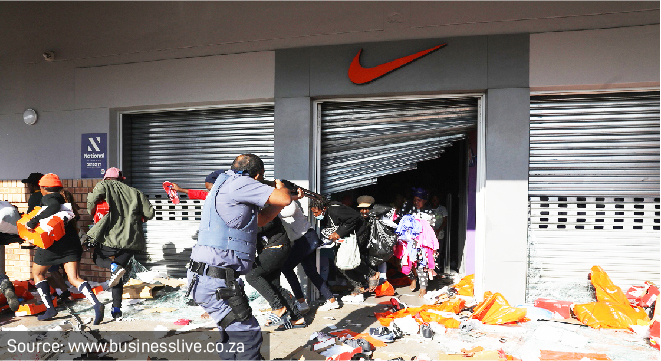The South African Special Risk Insurance Association (Sasria) was “not sure” why its risk analysis programme missed the warning signs of the unrest in July, according to the “Report of the expert panel into the July 2021 civil unrest”.
According to the report, Sasria said the attack on the country’s economic infrastructure resulted in the “most expensive riots in our history”.
It has been estimated that the riots cost the economy some R50 billion and led to at least 354 deaths.
The 154-page report is dated 29 November 2021, but it was only released by the Presidency on 7 February. It was written by the expert panel appointed by President Cyril Ramaphosa on 5 August last year.
Click here to download the full report or click here to read it online.
According to the report, Sasria’s risk analysis was based on “several predictable” social and political fallout scenarios.
“Their risk analysis put emphasis on probable scenarios, such as a national shutdown strike manifesting in several cities, a cyber-attack on the country’s infrastructure, a terror attack, a severe breakdown in energy provision, and the effects of climate change, such as water shortages.
“Even with these grim risk scenarios, Sasria did not predict the deluge of violence, looting and killing” that befell parts of KwaZulu-Natal and Gauteng.
Sasria received more than 14 000 claims valued at R30bn, of which 80% were from KwaZulu-Natal.
The report said Sasria was faced with the task of convincing reinsurers, many of which are foreign companies, to continue underwriting the risks its covers.
Security services failed to do their job
The panel said it was beyond doubt that the police and intelligence services had failed to respond timeously, appropriately or sufficiently to the violence.
It said there was “a sense of deep bewilderment” at the absence of the police at a time when communities needed them most.
“In most areas, the police became spectators as one mall after another was destroyed; as one truck after another was torched; as people came back day after day to finish looting whatever was left from the previous day,” according to the report.
As to the reasons for the reasons for the violence, the panel said it could be viewed in the context of “multiple crises and challenges facing South Africa”, of which the most important were:
- The weakness of state institutions;
- High unemployment, with youth unemployment above 70%, and no consistent, continuous plan to address this challenge;
- High levels of poverty and deep inequality;
- Poor spatial planning, leading to overcrowded and unsuitable living conditions for many;
- Rampant corruption at various levels of government;
- State capture; and
- The frustrations caused by the Covid-19 restrictions, adding to the feeling of despair among the population.
It said former president Jacob Zuma’s rejection of the decisions of the Zondo Commission was a major factor in the build-up to and the actual violence and looting.
According to many of the submissions, Zuma’s incarceration at the Estcourt correctional facility was the spark that ignited the orgy of violence.
Submissions made to the panel pointed to elements of organisation behind the looting of malls, combined with opportunistic looting. It also received submissions that some of the attacks were planned in hostels.
“It is clear that the planners wanted the looting to look like they were spontaneous; a phenomenon that we have coined ‘organised spontaneity’.”
ANC factional battles ‘a risk to stability’
Civil society groups, think tanks, business and community associations, and even members of the government told the panel that what appeared to be factional battles in the ANC have become “a serious source of instability” in the country.
“This is a matter of great concern, and the reasons for this need to be identified sooner rather than later.”
The report said little has changed in the conditions that led to the unrest, leaving the public worried that there might be similar eruptions of large-scale unrest in future.
“The question, many argue, is not if and whether more unrest and violence will occur, but when it will occur.”
Comment
The entire report makes for sobering reading and is an indictment of multiple levels of failure across government. However, I was particularly struck by the observation in this paragraph: “In most of the affected shopping malls we visited, the managers of the malls informed us of how they watched their regular customers, who used to be frequent, friendly visitors to the management offices, become part of the ravaging mobs. They sat down with them after the violence subsided to try and make sense of it. They could not get clear answers from them on why this happened.”



